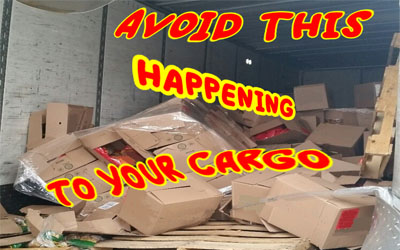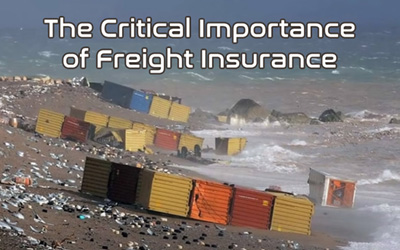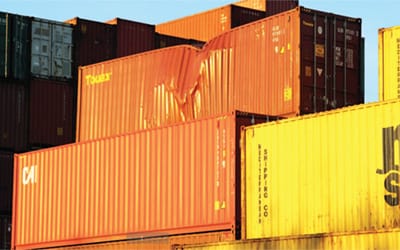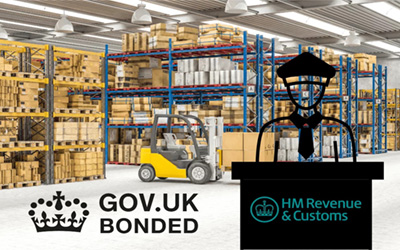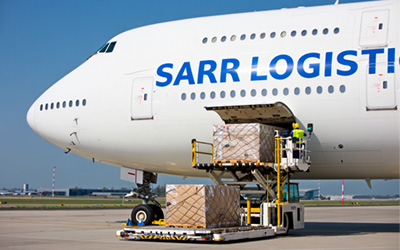Understanding the Most Common Shipment Hazards
When it comes to shipping goods, protecting them adequately is pivotal in ensuring their safe arrival. Understanding the risks involved in transit is the cornerstone of effective packaging. In this comprehensive guide, we’ll delve into the most common hazards that standard (non-hazardous) products encounter during transportation and explore best practices to mitigate these risks. Spending a bit of time and money at the initial packing stage of your cargo will save you money and stress in the long term.
5 Common Shipment Hazards from Incorrect Packing
 1, Punctures & Abrasions
1, Punctures & Abrasions
2, Compression
3, Environmental Exposures
4, Shipment handling
5, Shock
5 Ways to Avoid Shipment Hazards by Correctly Packing:
 1, Banding and Strapping
1, Banding and Strapping
2, Edge Protection
3, Over-pack or Paperboard
4, Bracing
5, Pre-Shipment testing
Punctures & Abrasions
During air transportation, goods share space with other items in trucks and shipping containers, also known as LCL less than container load or group-age, which can lead to punctures and abrasions.
This occurs when shipments come into contact with other cargo or due to inadequate internal packaging that fails to prevent contents from shifting, thereby compromising the exterior packaging’s integrity.
If you intend to use group-age as it is a cheaper option and much more convenient when you are only sending a few items or palettes, make a point of packing your goods well as you just never know what they are going to be bundled with.
Compression
The stacking of cargo on top of a shipment can result in compression or crushing. Unsupported exterior packaging might give way under pressure, causing damage. Properly configured inner packaging is essential to provide firm support, reducing the likelihood of compression during transit.
As the shipping industry tighten their belts you will often find companies getting the maximum load for space ratio from containers and lorries alike. Unless you have a dedicated vehicle or FCL full container load, you will need to make it abundantly clear that your palette should not be stacked on.
This is a common misconception by companies as they feel common sense would prevail, but as jut mentioned the companies delivering the goods are always trying to get maximum weight to space ratio out of their containers or trucks. Make sure you clearly mark the goods.
Environmental Exposures
Environmental factors such as climate and geography significantly contribute to product damage. Excessive moisture or water not only harms shipment contents but also compromises packaging integrity. For instance, corrugated cardboard boxes’ adhesive can be weakened by moisture, potentially leading to box failure during transit.
If you are sending goods abroad and you know they are going to be at sea for four or five days don’t rely on the container being air tight, some of the containers used are years old and can be vulnerable to the weather conditions, just be mindful of the change in temperature depending on where and when you are sending your goods.
Shipment Handling
Throughout transit, an air shipment undergoes numerous touch points, particularly when not palletized or exceeding 150lbs/70kgs, necessitating manual lifting. Such shipments are prone to increased exposure to drops and sliding.
Properly securing palletized shipments is crucial to prevent tipping or sliding during handling. We have all seen baggage handling at air ports, how your cases get thrown around, if you keep this picture in mind when packing up your goods for air freight or road freight you should make the right choices for your packing. Ultimately you want to pallatize your goods and securely fix them to the pallet.
Shock
The journey from the shipper’s dock to the customer’s door involves various modes of transportation (trucks, forklifts, conveyors, etc.), increasing the possibility of shock to the packaging. Damage can occur if the inner or exterior packaging fails to withstand the handling elements encountered during transit. As mentioned above keep in mind the picture of baggage handlers at airports.
Safeguarding Your Goods
To prevent these hazards from impacting your shipment, and company finances employing effective methods to secure goods is paramount. If you are proactive you will save your company money and time. This is a costly mistake often overlooked as companies are always under pressure to cut back and make savings.
The main point to remember is you have spent thousands on manufacturing and production costs to create a product that you are proud of and want your customer to experience in its ultimate condition. Don’t get caught by cutting costs on the packing process and make sure it arrives in the same condition it left your factory.
Two primary methods are banding and shrink-wrap, they stand out for their efficiency, especially for outsize or palatalized shipments.
Shrink Film/Shrink-wrap
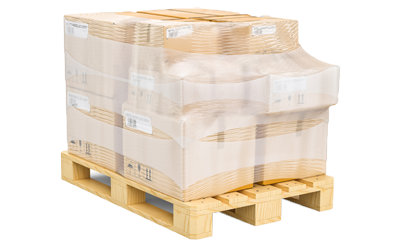 Shrink-wrap application involves securing the film’s leading edge to the pallet or fork able base. It should be applied by tightly rotating the film horizontally around the goods, ensuring a 50% overlap on the previous layer of film. Diagonal criss-crossing and tight overlaps at the top and base of the pallet ensures comprehensive coverage.
Shrink-wrap application involves securing the film’s leading edge to the pallet or fork able base. It should be applied by tightly rotating the film horizontally around the goods, ensuring a 50% overlap on the previous layer of film. Diagonal criss-crossing and tight overlaps at the top and base of the pallet ensures comprehensive coverage.
Banding/Strapping
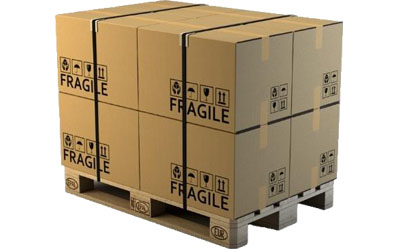 Correctly applied strapping is an ideal way to secure shipments. Following the IATA standard of four-way (vertical) strapping, loop the first piece underneath the pallet void and over the goods, securing it vertically.
Correctly applied strapping is an ideal way to secure shipments. Following the IATA standard of four-way (vertical) strapping, loop the first piece underneath the pallet void and over the goods, securing it vertically.
Apply at least four straps in all directions and use horizontal edge protectors to prevent bands from cutting into top box edges. Additionally, utilize shrink-wrap for added environmental protection.
Edge Protectors
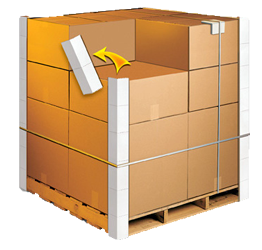 Vertical edge protectors play a dual role in reducing damage to box edges during transport and stabilizing the load. Employ both horizontal and vertical edge protection, ensuring the vertical protectors extend from top to bottom.
Vertical edge protectors play a dual role in reducing damage to box edges during transport and stabilizing the load. Employ both horizontal and vertical edge protection, ensuring the vertical protectors extend from top to bottom.
Over-Pack or Paperboard
Position paperboard on the top, base, and sides to create a protective barrier. They effectively distribute the weight of shipments against the base slats of the pallet, reducing pressure on specific points. Depending on the good which are on the pallet you could use a stronger material to stop punctures to the packing.
Bracing
For outsize pieces, such as cable reels or engines, ensure proper bracing against the pallet using wood or metal. Bracing prevents sideways movement during transportation, maintaining stability. This also is effective once loaded on the container as shown in the picture.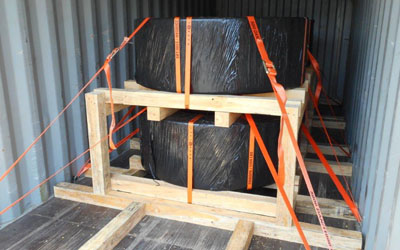
An imperative move as you can imagine when container ships hit storms and choppy water the containers are thrown from side to side. Also when they are lifted by cranes in high wind they will get rocked around causing cargo to move.
Pre-Shipment Testing
Conducting package performance tests is highly recommended to verify packaging effectiveness. These tests simulate transportation rigors, helping evaluate product protection performance and enabling necessary packaging adjustments before widespread implementation.
Laboratories offer controlled environments to assess a package’s ability to withstand various transportation hazards like shock, compression, handling, vibration, and environmental exposures.
Know your goods and their vulnerabilities it will save you a lot of money and disruption in the supply chain long term, be proactive and get ahead of your competition. Spending a few extra pounds now and getting it right will ultimately win you more customers and is beneficial to the long term future of your company.
Conclusion
By understanding these common shipment hazards and implementing appropriate measures to secure your goods, you can significantly minimize the risks associated with transit, ensuring the safe arrival of your products to their destination.
Saving you money, helping with your insurance policies, and gaining you custom for the longevity of your company. If you need any help or advice on packing and shipping of goods please contact us we are always here to help.


